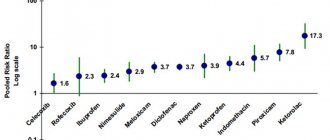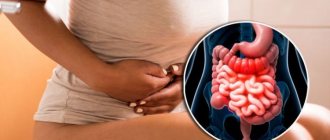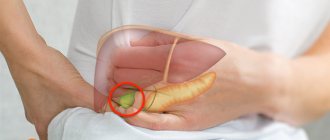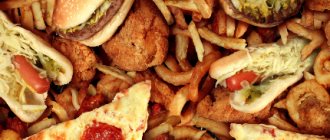It is logical to assume that increased gas formation (flatulence) is a consequence of excess gas, which begins to accumulate in the intestines. More than half of all people with various diseases of the gastrointestinal tract (GIT) experience signs of increased gas formation in the intestines on an ongoing basis1.
Most people can eliminate flatulence, but you will have to make an effort and figure out which remedies are most effective. To do this, it is necessary to understand the processes of occurrence and accumulation of gases in the intestines.
Causes of flatulence in children
In the first year of life, the baby still produces insufficient digestive enzymes, gastric motility is weak, so even with minor violations of the feeding rules, flatulence occurs. This may be too frequent and/or abundant feeding, incorrect balance of proteins, fats and carbohydrates, etc. In addition, infants swallow a lot of air when feeding, which also causes gas formation. Source: P.L. Shcherbakov Flatulence in children // Difficult Patient, 2006, vol. 4, no. 9, pp. 66-72
Other causes of gas in newborns:
- the process of adaptation of the body to life outside the womb;
- stress;
- age-inappropriate food;
- changing formula;
- overfeeding;
- introducing complementary foods too early;
- swallowing gas while crying or screaming;
- restless behavior, overexcitation, unstable emotional state;
- improper diet of the mother if the child is breastfed;
- prematurity;
- lactase deficiency;
- allergy to cow's or goat's milk protein;
- dysbiosis.
In children 2-4 years old, the reasons for increased gas formation are different:
- consumption of sweets, baked goods, white bread, foods with coarse fiber and starch;
- physical inactivity, inactive lifestyle;
- excess body weight;
- dysbacteriosis;
- congenital deficiency of digestive enzymes;
- stress, nervous tension;
- abuse of carbonated drinks;
- habit of chewing gum.
The psychological factor is very important for schoolchildren. Gases occur due to stress or psychological constipation, neuroses that affect the functioning of the gastrointestinal tract.
After 8 years the reasons are as follows:
- binge eating;
- physical inactivity;
- impaired intestinal motility, dysbacteriosis;
- neuroses;
- drug abuse;
- passion for “junk foods”, carbonated drinks;
- unbalanced nutrition, because from this age children already choose for themselves what they want to eat and what not, argue with their parents, refuse healthy food;
- intestinal infections.
Types of flatulence in older children:
- Disgestive. A consequence of a deficiency of digestive enzymes, the breakdown of undigested food remains by the intestinal microflora and, as a result, the release of large amounts of gases.
- Nutritional. Occurs when consuming gas-forming foods and drinks.
- Dynamic. It develops if the motility of the gastrointestinal tract is impaired, which leads to the accumulation of undigested food residues in the intestines.
- Dysbiotic. Explained by intestinal dysbiosis. The main reason is long-term antibiotic therapy, which suppresses the activity of microflora and stimulates the growth of colonies of foreign microorganisms. Source: N.L. Pakhomovskaya, M.M. Venediktova Flatulence: causes and ways of correction // Consillium Medicum. Pediatrics, 2021, No. 2, pp. 32-36
Causes
In addition to overeating and intolerance to any foods, increased gas formation develops due to the progression of diseases of the gastrointestinal tract, for example, cholecystitis, dysbacteriosis, gastritis, duodenitis, pancreatitis, colitis, intestinal obstruction, etc. In adult patients, the reason often lies in eating lunch while running at a fast pace. In addition, a lack of enzymes and disrupted intestinal microflora can provoke the production of gases. In some cases, after surgery in the peritoneal area, intestinal motility slows down, causing food to be processed slowly.
Symptoms of the disease in children of different ages
For children under one year old
- Restlessness, frequent crying.
- Visually noticeable bloating.
- Stool disorders - diarrhea or constipation, which is especially typical for lactase deficiency.
- Belching, hiccups.
- Lack of appetite - breast refusal.
- A few minutes after feeding, the baby tries to pull his legs towards his chest.
For children of older age groups
- Rumbling in the stomach, pain, feeling of fullness.
- Nausea, vomiting.
- Increased volume of gases that may escape uncontrollably.
- Bloating, which is visually noticeable in a child during flatulence.
- Feeling of a full stomach, lack of appetite.
- Dyspnea.
- Constipation and diarrhea, alternating with each other.
A characteristic feature of the disease is the disappearance or significant weakening of symptoms after the release of gases.
Ways to manifest flatulence
Flatulence in adults is also characterized as swelling or bloating, during which discomfort occurs in the abdominal area, accompanied by rumbling, belching, and sometimes constipation or diarrhea. Attacks of spasms and pain are possible. Flatulence can also occur with the constant release of gases that have an odor. The condition improves significantly after a person has bowel movements. As a rule, such disorders appear in the afternoon, when the digestive system is actively working.
If the accumulation of gases occurs in a certain part of the intestine, so-called local flatulence, pain is observed. When gases are retained at the bend of the intestine, where the spleen is, in addition to the standard manifestations, pain is felt on the left side and severe bloating. Gases in the liver area are manifested by a feeling of overeating and pain on the right side under the ribs and shoulder blade.
flatulence in adults
With flatulence, which occurs due to dysfunction of the small intestine, bloating is observed, while the colon is characterized by a feeling of fullness, distension on the sides. In addition to the standard manifestations, the patient experiences vomiting, shortness of breath, unpleasant belching, heart pain, rapid heartbeat, and general weakness.
Flatulence, which is observed over a long period of time, not only has a detrimental effect on human health (heart problems, insomnia, weakness), but also limits the ability to communicate with other people.
Treatment of children of different age groups
Treatment methods for the disease depend on age. Diet, medication, and lifestyle changes may be indicated.
What help can be provided for intestinal flatulence in an infant?
First aid for flatulence in children involves alleviating the condition. A decoction of chamomile and “No-spa” (drotaverine hydrochloride) will help relieve intestinal spasms and ease colic. You can stimulate the passage of gases with the help of Espumisan.
Important! Children under three years of age should not be given medications that have not been approved by the supervising pediatrician.
can be placed on the baby's stomach . Massage is also used to relieve discomfort: circular movements without pressure in a clockwise direction. The child's condition can be alleviated by placing him on his back and bending his legs several times, each time bending them towards his stomach and straightening them. Source: A.N. Surkov, V.V. Chernikov Symptom of flatulence in young children: causes and ways of correction // Pediatric pharmacology, 2013, v. 10, no. 1, pp. 78-82
If these measures do not help, a special gas outlet catheter can be used.
A nursing mother should be careful when consuming gas-forming foods - legumes, cocoa, coffee, chocolate, sauerkraut, baked goods, muffins, grapes, fresh vegetables and fruits.
After each feeding, you need to hold the baby upright so that excess air comes out with a burp.
You can use any medications only as prescribed by a doctor. This could be Espumisan, enterosorbents, eubiotics.
Treatment of older children
In some cases, digestive enzymes are prescribed in tablets. Changes are made to the diet, from which harmful foods are excluded: carbonated drinks, chips, legumes, potatoes, raw vegetables and fruits, chocolate, cocoa. It is important that the child does not overeat. To relieve spasms, improve motility and increase the tone of the intestinal walls, the doctor may prescribe a special drug, for example Iberogast.
It is imperative to observe what the child eats to determine what food causes bloating. Food should be steamed or boiled, and its temperature when served should be moderate. It is recommended to drink more - still water, herbal decoctions. You need to eat 4-6 times a day in small portions and chew your food thoroughly.
Authorized products:
- low fat cheeses;
- dairy products;
- lean fish;
- porridge without milk;
- rabbit meat, poultry;
- pumpkin, beets;
- egg dishes (not fried).
The child should move more, walk, play with peers. It is important to protect him from stress.
Ways to get rid of bloating
Flour products can provoke flatulence
Compliance with preventive measures will help significantly alleviate the condition. You should avoid provoking foods. Foods with small amounts of simple carbohydrates will not cause flatulence.
You need to add dried fruits, lean meat, nuts and eggs to your diet. The most harmful foods are confectionery, fruit juices, soy, cauliflower and Brussels sprouts.
Drinks high in fructose can also cause bloating. It is also very important to understand that each patient has individual provoking foods, so it is necessary to independently determine a safe diet.
Disease prevention
The child should eat in a calm environment. While eating, you should not turn on the TV, because it is distracting and encourages the swallowing of air with food. Meals should be spaced throughout the day and always be at the same time. You can’t eat hastily and on the go. It is recommended to place the baby on his stomach for 5 minutes before feeding. After eating, place it in an upright position for a few minutes.
Sources:
- P.L. Shcherbakov. Flatulence in children // Difficult Patient, 2006, vol. 4, no. 9, pp. 66-72.
- N.L. Pakhomovskaya, M.M. Venediktova. Flatulence: causes and ways of correction // Consillium Medicum. Pediatrics, 2021, No. 2, pp. 32-36.
- A.N. Surkov, V.V. Chernikov. Symptom of flatulence in young children: causes and ways of correction // Pediatric pharmacology, 2013, vol. 10, no. 1, pp. 78-82.
Grek Elena Anatolyevna Clinic
Author of the article
Grek Elena Anatolyevna
Doctor of the highest qualification category
Specialty: gastroenterologist
Experience: 23 years
The information in this article is provided for reference purposes and does not replace advice from a qualified professional. Don't self-medicate! At the first signs of illness, you should consult a doctor.
Which doctor treats flatulence?
With any problems of impaired functioning of the gastrointestinal tract, contact a gastroenterologist. To consult with a doctor, you must first make an appointment with a gastroenterologist; to do this, choose any method convenient for you:
- call the clinic +7 (495) 103-99-55,
- order a call back,
- leave a request for an appointment using a convenient form on the website:
Flatulence is a phenomenon that requires serious attention from both the patient and the attending physician.
IMPORTANT! The fact is that increased gas formation can appear both due to the specific nature of the food (rough, requiring long-term digestion), and due to the occurrence of pathology of the gastrointestinal tract.
In any case, it is necessary to refrain from self-medication, which will certainly lead to complications. Make an appointment with a gastroenterologist at the Kuntsevo Medical and Rehabilitation Center to determine the causes of flatulence and determine treatment tactics to eliminate the symptom.
SIGN UP
Prices
| Name of service (price list incomplete) | Price |
| Appointment (examination, consultation) with a gastroenterologist, primary, therapeutic and diagnostic, outpatient | 1750 rub. |
| Prescription of treatment regimen (for up to 1 month) | 1800 rub. |
| Consultation (interpretation) with analyzes from third parties | 2250 rub. |
| Consultation with a candidate of medical sciences | 2500 rub. |
| Ultrasound of the abdominal organs (comprehensive) | 2900 rub. |
| Ultrasound of the retroperitoneal space (and retroperitoneal lymph nodes) | 1400 rub. |
| Ultrasound of the gallbladder | 1400 rub. |
| Ultrasound of the abdominal organs (comprehensive) | 2900 rub. |
| Ultrasound of the liver | 1600 rub. |
| Ultrasound of the spleen | 1600 rub. |
| Diagnosis of Helicobacter pylori infection (HELPIL test) | 1200 rub. |
| Colonoscopy | 5050 rub. |
| Biopsy during endoscopic examination (1 biopsy) | 1000 rub. |
| Body composition assessment - bioimpedance analysis | 2150 rub. |
| Body composition assessment - repeated (bioimpedance analysis) | 1750 rub. |
| Esophagogastroduodenoscopy (EFGDS) | 3050 rub. |
Treatment methods
To normalize intestinal motor function, the gastroenterologist develops a comprehensive treatment. As part of therapy, he prescribes the use of pharmacological agents to normalize the microflora of the colon and the breakdown of gases:
- enzymes of different groups to restore missing elements in the body,
- sorbents that reduce bloating,
- prokinetics, accelerating the movement of food through the intestines and promoting the removal of gases,
- defoamers that destroy gas bubbles,
- probiotics and prebiotics that facilitate the digestion of food in the intestines.
If the test results reveal gastrointestinal diseases, the gastroenterologist selects therapy aimed at eradicating their cause.









